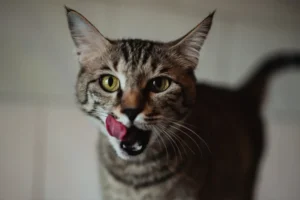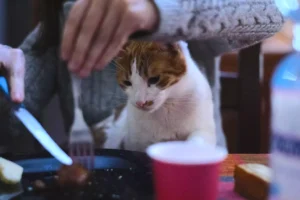Many cat owners often wonder, ‘how long does it take for a cat to poop after eating?’ The times can vary depending on what you feed your cat and whether the cat is healthy.
If you let your cat eat whenever it wants, it can go whenever it wants, but usually 30 minutes after eating, up to a few hours. Other times, cats will go 3-4 hours between eating and pooping. Kittens typically go immediately after eating (or during), which is normal.
Let’s look at what is normal for cats regarding eating, digesting, and pooping.

How Soon After a Meal Do Cats Poop?
If your cat is fed at will, they can go whenever they want, but usually about 30 minutes after eating. However, this doesn’t mean that the cat has finished digesting the food and may simply be pooping from the last meal.
If you have regular mealtimes, feeding your cat every 6 hours is typical, with smaller amounts. Cats’ digestive tracts are shorter than those of herbivores or humans. Thus food passes through rapidly.
My kitten, on the other hand, poops immediately after eating. He may occasionally leave his meal halfway through, poop, and then return to finish it. This behavior is particularly common in kittens. Their digestive systems are still developing, and their smaller stomachs process food much quicker.
It’s also why they have more frequent meals. Adult cats, on the other hand, have slower digestion times, allowing them to have fewer, more substantial meals. This immediate pooping behavior in kittens tends to slow down as they mature and adjust to a regular feeding pattern.
I try to feed them with only the best kitten foods, but you have many options.
Interestingly enough, kittens who cannot be breastfed are fed, then stimulated to go potty with a warm washcloth to help pass stools and then slumber.
How Long Does It Take a Cat to Digest Food?
Cats usually digest food within a 12-hour window, though this can stretch to 24 hours depending on factors like diet type, age, overall health, and their activity levels. Undigested food might be expelled sooner, especially if the cat faces any digestive issues.
If your cat vomits after a rapid change in her diet, try gradually incorporating the new food into the old. Slight digestive disturbances, such as watery stools, are usual for the first week after switching diets, but she should not vomit immediately after eating. Talk to your vet if you have any concerns.
Meat protein is the most easily digestible protein for cats. They have a short digestive system, which is ideal for predatory animals. On the other hand, domestic cats are gradually adjusting to digesting plant material better due to dry cat food.
Most dry cat food contains plant filler because it is inexpensive. Many cats are so accustomed to this in their diet that removing it causes diarrhea (even if you gradually do so).
Factors affecting the digestion time
Here are some factors that can affect how often your cat needs to poop:
- Diet. The type and quantity of food your cat eats can greatly impact their bowel movements. Cats on a high-carbohydrate diet may need to poop more often than those on a high-protein diet.
- Water intake. Adequate hydration is important for proper digestion, and drinking enough water can help regulate bowel movements. Cats who do not drink enough water may have harder and less frequent stools.
- Age. Kittens and older cats may need to poop more frequently than adult cats. Older cats may have a decrease in intestinal motility, leading to less frequent bowel movements.
- Stress. Stress can alter a cat’s normal digestive processes and lead to changes in bowel movements, potentially causing constipation or diarrhea.
- Health conditions. Certain health conditions, such as digestive disorders, can affect how often a cat needs to poop. Examples of health conditions that can impact a cat’s bowel movements include inflammatory bowel disease (IBD), colitis, constipation, and parasites such as worms.
- Medications. Certain medications, such as antibiotics, can alter a cat’s digestion and bowel movements. Some common antibiotics that can cause changes in bowel movements in cats include amoxicillin, clavulanic acid, and metronidazole.
- Obstruction. Rarely, a cat may eat something that may be difficult to digest, such as thread, wool, paper, or just plain old aluminum foil. If you notice any signs like lethargy, vomiting, or a loss of apetite, you might want to look into calling your vet.
How Can You Get a Cat to Poop?
Pumpkins can be helpful. Due to the stress of a new environment and person, my cat didn’t poop for two days when I first received her. A mixed pumpkin or quash into her food to help her poop.
If your cat still doesn’t poop, take him to the vet as soon as possible. You can also give them a tablespoon of canned pumpkins. It usually works within 10 to 12 hours.
My approach is that if the litter box is spotless, the cat may not recognize it as a litter box. Or she realizes that it must remain clean if you clean it.
I advise transferring part of the dirty stuff from the “old” box to the clean one. Similarly, jump here to learn how to stop a kitten from using an adult cat’s litter box.
When Do Cats Typically Poop After Eating?
Most cats poop immediately after eating, and this usually due to gastrocolic reflex.
The gastrocolic reflex is a bodily response that activates the intestines to make room for incoming food. This reflex is stronger in some cats than others, causing them to feel the urge to defecate shortly after eating.
If the feces is normal, this is common, depending on what he eats and how frequently he goes. My kitties poop either right before mealtime or 30 minutes later. It’s normal as long as it’s his daily routine.
You’ll discover that what’s “normal” for one cat isn’t always “normal” for another. If the cat is regular, this is great. It is not usually a problem if a cat poops immediately after eating unless they have diarrhea.
How Do You Know if the Cat Is Going to Poop?
A cat will occasionally elevate its tail when needing to poop. They usually stand in a squat with their tail raised and twitching. My cat used to scratch the floor with his front paws, seemingly searching for a nice area.
I’d grab him and show him his litter box at that point. It served its purpose. I would show him his water and then give him food if he scratched but didn’t need to use the litter box. It was always one of these three possibilities.
Cats poop and pee in human presence for security reasons. These are two vulnerable acts that will comfort, particularly stressed cats. So, if you’ve been away and returned to the cat, there’s a chance it’ll poop.
How Long Can a Cat Go Without Pooping?
According to WebMD, a cat should not go for 48 hours without pooping. Your cat could be in pain due to constipation, and because of the pain, it may not be defecating. Constipation for this long might induce calcification of the feces in the GI system, which can be fatal to your cat.
My cat occasionally goes a day without pooping; the next day, he has a considerably larger stool. Just keep an eye out for her going to the toilet and straining to poop. It’s an excellent idea to put water in her food to make it easier to poop.
Cats Pooping FAQs
How Long can cats go without peeing?
It could be an illness, parasites, or food sensitivity. If her poo is watery, her body isn’t absorbing enough of the water in her diet, leaving her thirsty and unable to pee. When a cat isn’t urinating, it’s critical to get them to the vet as soon as possible because dehydration can lead to kidney problems.
What makes a cat eat but not poop?
The cat could be sick, so talking to the vet is the safest option. The change in litter substrate may make the cat feel uneasy about pooping, as cats are notorious for being picky about their litterbox habits. Some cats don’t like traveling and change. Going potty exposes a cat to danger, so when they are agitated or scared, they will hold it until they feel safe again.
Do cats like when you watch them poop?
Most cats like it when their owners watch them poop. They are vulnerable when pooping and look to you for safety signs. The vulnerability stems from their incapacity to turn around and see what’s behind them. She essentially wants you to be her security guard so she can relax.
Alex, a passionate animal lover, has experience in training and understanding animal behavior. As a proud pet parent to two dogs and three cats, he founded AnimalReport.net to share insights from animal experts and expand his knowledge of the animal kingdom.









